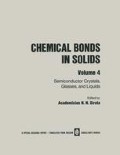Abstract
An electron-valence scheme of chromium disilicide is proposed on the basis of a comparison of a crystallochemical analysis of this compound with its electrical and magnetic properties. The bond scheme in CrSi2 explains satisfactorily the anisotropy shown by the electrical and thermal conductivity of its single crystals. The anisotropy of the thermoelectric power of CrSi2 is explained by the fact that holes with a different effective mass are always present because of the heterodesmic nature of the chemical bonds (Cr-Si, Si-Si). On the basis of an analysis of the characteristic features of the change of electrical properties in the “intrinsic” conduction region, it is concluded that the free 3d level of the chromium atoms in CrSi2 acts as the acceptor and is situated, as regards energy, between the edge of the valence band and the bottom of the conduction band. From analysis of the experimental and calculated density of CrSi2, it is proposed that the high (1020 cm−3) hole density in stoichiometric samples at room temperature is due to the “molecular” imperfection of the crystal lattice.
“Semiconductors,” pp. 291–298 (see page 3).
Access this chapter
Tax calculation will be finalised at checkout
Purchases are for personal use only
Preview
Unable to display preview. Download preview PDF.
Literature Cited
H. J. Wallbaum, Z. Metallkunde, 33: 378 (1941).
G. B. Bokii, Introduction to Crystal Chemistry [in Russian], Izd. MGU, Moscow (1954).
L. N. Guseva and B. I. Ovechkin, Dokl. Akad. Nauk SSSR, 112: 681 (1957).
E. N. Nikitin, Zh. Tekh. Fiz., 28: 23 (1958).
D. A. Robins, Phil. Mag., 3: 313 (1958).
L. D. Dudkin, Doki. Akad. Nauk SSSR, 127: 1203 (1959).
L. D. Dudkin, Fiz. Tverd. Tela, 2: 397 (1960).
L. D. Dudkin and E. S. Kuznetsova, Porosh. Met., No. 6, p. 20 (1962).
T. Sakata, T. Tokushima, and Z. Kinzoku, Gijutsu Kenkyù — Hókoku, 6 (1): 1 (1963).
D. Shinoda, S. Asanabe, and Y. Sasaki, J. Phys. S.c. Jap., 19: 269 (1964).
I. Z. Radovskii, T. S. Shubina, P. V. Gel’d, and F. A. Sidorenko, Porosh. Met., No. 2, p. 33 (1965).
I. Z. Radovskii, F. A. Sidorenko, and P. V. Gel’d, Fiz. Metal. Metalloved., 19: 915 (1965).
B. K. Voronov, L. D. Dudkin, N. I. Kiryukhina, and N. N. Trusova, Porosh. Met., No. 1, p. 73 (1967).
B. K. Voronov, L. D. Dudkin, N. I. Kiryukhina, and N. N. Trusova, lzv. Akad. Nauk SSSR, Neorg. Mater., 4: 58 (1968).
B. K. Voronov, L. D. Dudkin, N. I. Kiryukhina, and N. N. Trusova, lzv. Akad. Nauk SSSR, Neorg. Mater., 4: 325 (1968).
B. K. Voronov, L. D. Dudkin, and N. N. Trusova, Kristallografiya, 12: 519 (1967).
M. G. Shirmazan and M. E. Dyatkina, lzv. Akad. Nauk SSSR, Otd. Khim. Nauk, No. 9, p. 1553 (1959).
B. I. Davydov and I. M. Shmushkevich, Usp. Fiz. Nauk, 24: 21 (1940).
C. A. Coulson, Valence, Oxford University Press, London (1961), p. 286.
L. E. Orgel, Introduction to Transition-Metal Chemistry: Ligand-Field Theory, Methuen, London (1960), p. 38.
G. Herzberg, Atomic Spectra and Atomic Structure, Dover, New York (1944).
Editor information
Editors and Affiliations
Rights and permissions
Copyright information
© 1972 Consultants Bureau, New York
About this chapter
Cite this chapter
Voronov, B.K., Dudkin, L.D., Trusova, N.N. (1972). Characteristic Features of the Physicochemical Structure of Chromium Disilicide. In: Sirota, A.N.N. (eds) Chemical Bonds in Solids. Springer, New York, NY. https://doi.org/10.1007/978-1-4684-8682-7_4
Download citation
DOI: https://doi.org/10.1007/978-1-4684-8682-7_4
Publisher Name: Springer, New York, NY
Print ISBN: 978-1-4684-8684-1
Online ISBN: 978-1-4684-8682-7
eBook Packages: Springer Book Archive

